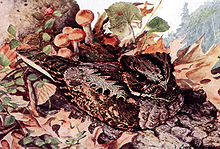Sonata for flute and piano (Martinů)
The sonata for flute and piano by the Czech composer Bohuslav Martinů (1890–1959), composed in 1945, is dedicated to the flutist Georges Laurent . Your final movement is inspired by the call of the North American black-throated nightjar ( Antrostomus vociferus ).
Origin and premiere
Bohuslav Martinů composed his Flute Sonata in June and July 1945 while on vacation in South Orleans on Cape Cod , Massachusetts, shortly after completing his 4th Symphony. At the time, Martinů was undecided whether he should stay in the United States, to which he had emigrated, or return to his Czech homeland.
The world premiere took place on December 18, 1949 in a recital organized by the New York Flute Club by the flautist Lois Schaefer . It is dedicated to the French flautist Georges Laurent, then principal flautist of the Boston Symphony Orchestra .
The sonata bears the number H 306 in Harry Halbreich's catalog raisonné and was published under the title “First Sonata”, but a second work in this line-up was no longer to follow.
characterization
The playing time of the three-movement sonata for flute and piano by Bohuslav Martinů is around 20 minutes. Their sentence names are:
- Allegro moderato
- adagio
- Allegro poco moderato
The first movement, the main theme of which is initially exposed by the piano, is characterized by characteristic syncope . This is followed by a melancholy, song-like slow movement, with an E flat minor line in the flute that ascends from the lower register to the third octave, then descends again. The middle section of the sentence is much more lively. The main theme of the lively, virtuoso final movement is inspired by the call of the North American black-throated nightjar ( Antrostomus vociferus , also known as Eastern whip-poor-will in their homeland ). In the memories of Martinů's wife Charlotte it says: “[…] One day we found a small black bird with a bluish belly that was injured. We cared for him, and when he was healed, Bohuslav taught him to fly. He sang under our window, and so it was that in Bohuslav's Sonata for Flute and Piano the theme of this bird's song, called Whippoorwill, appears. "
Individual evidence
- ↑ CD supplement Naxos 8.572467, Martinů: Chamber Music with Flute, Fenwick Smith (flute), Sally Pinkas (piano) a. a., text: Fenwick Smith
- ↑ cit. n. CD supplement Chandos CHAN 8823, Martinů: Flute sonata a. a., Susan Milan (flute), Ian Brown (piano), text: Edward Blakeman, translation: Renate Maria Wendel
literature
- Ursula Pešek, Željko Pešek: Flute music from three centuries . Bärenreiter, Kassel 1990, ISBN 3-7618-0985-9 , pp. 189-190.

